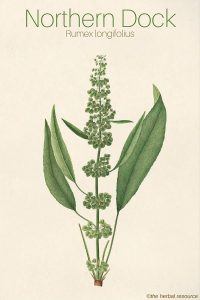Northern dock is closely related to yellow dock (Rumex crispus), and has similar medicinal properties.
In the past, the herb has been used traditionally both as a food source and medicinally but in today’s herbal medicine it does not play a big role.
In folk medicine, it was especially the root that was used, and then primarily for wound treatment.
One of the folk uses was to make an ointment by adding the smashed root in sweet or sour cream. This ointment was then used as a remedy for minor wounds, cuts, and scrapes, but especially for burns.
Henrik Harpestreng, a Danish botanical and medical author from the 1300’s, mentions the herbs in his writings where he states that the root of northern dock added to wine can be used as a treatment for diarrhea and decoction made from the root can be used to prevent constipation.
The root was also been used traditionally as a treatment for jaundice and delayed of menstruation.
The leaves were used as wraps and applied externally as a relief for gout and aching joints. Furthermore, the leaves were applied on wounds and boils to relieve pain and promote healing. The herb does contain high amounts of tannins which might explain why the herb was considered effective in this regard.
Northern Dock as Food
The Northern dock has been used for human consumption for centuries especially in times of famine.
In the past, it was common to peel away the outer parts of the stem and eat the inner part. The stems could be eaten raw, added to soups and stews or possibly ground and used as flour.
In spring the vitamin C-rich leaves were collected and used to make an “herbal stew”.
The seeds are a great source of energy and can be eaten fresh while they are still unripe.
When food was scarce, the ripe seeds were collected, washed to get rid of some of their sour taste and then ground to a flour. The flour was then used to make porridge or in bread making where it was mixed with real flour to make it last longer.
The roots which are rich in carbohydrates were eaten after they were soaked in water to lessen their sour taste.
[Read more about Northern Dock…]

Leave a Reply